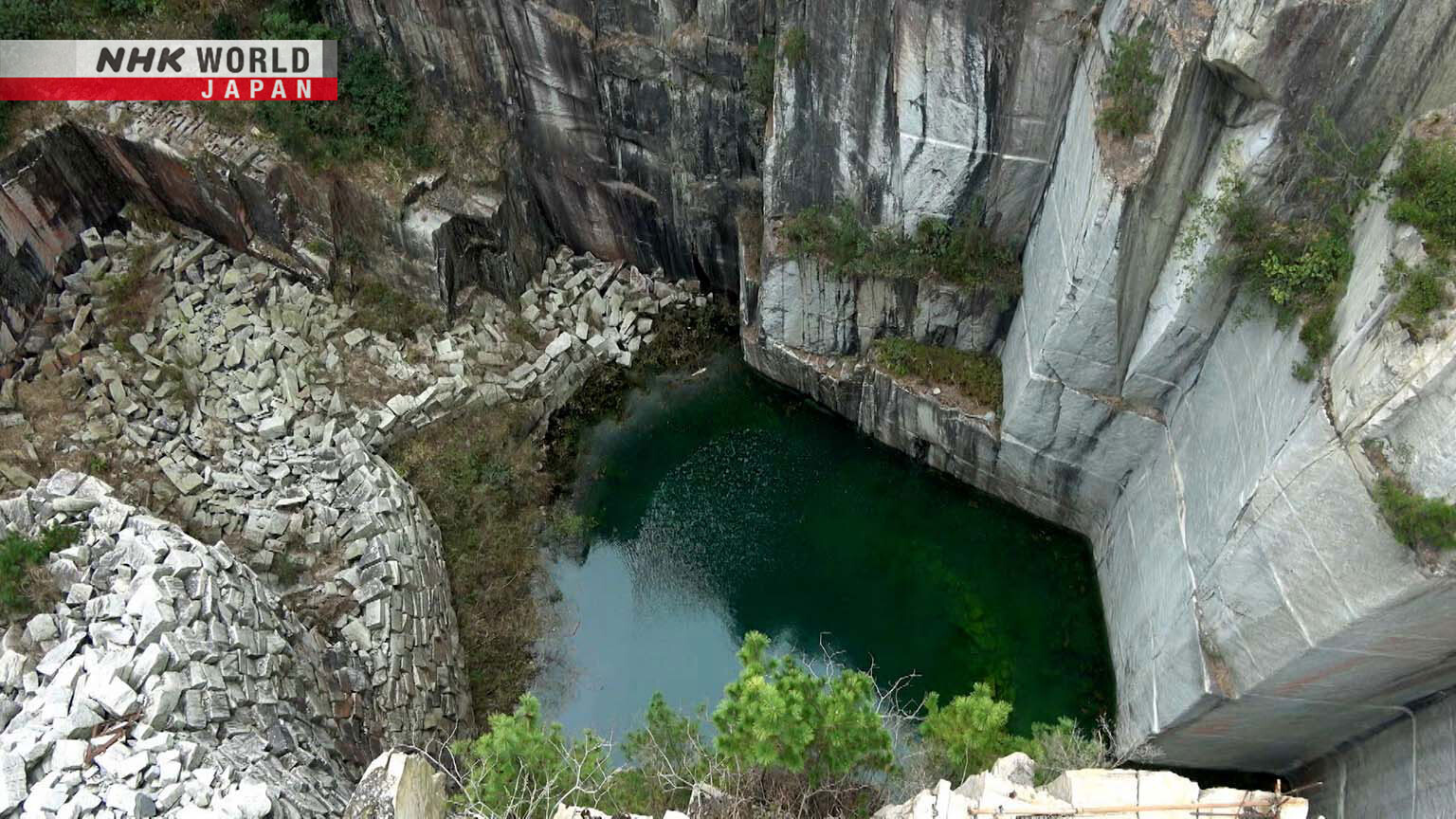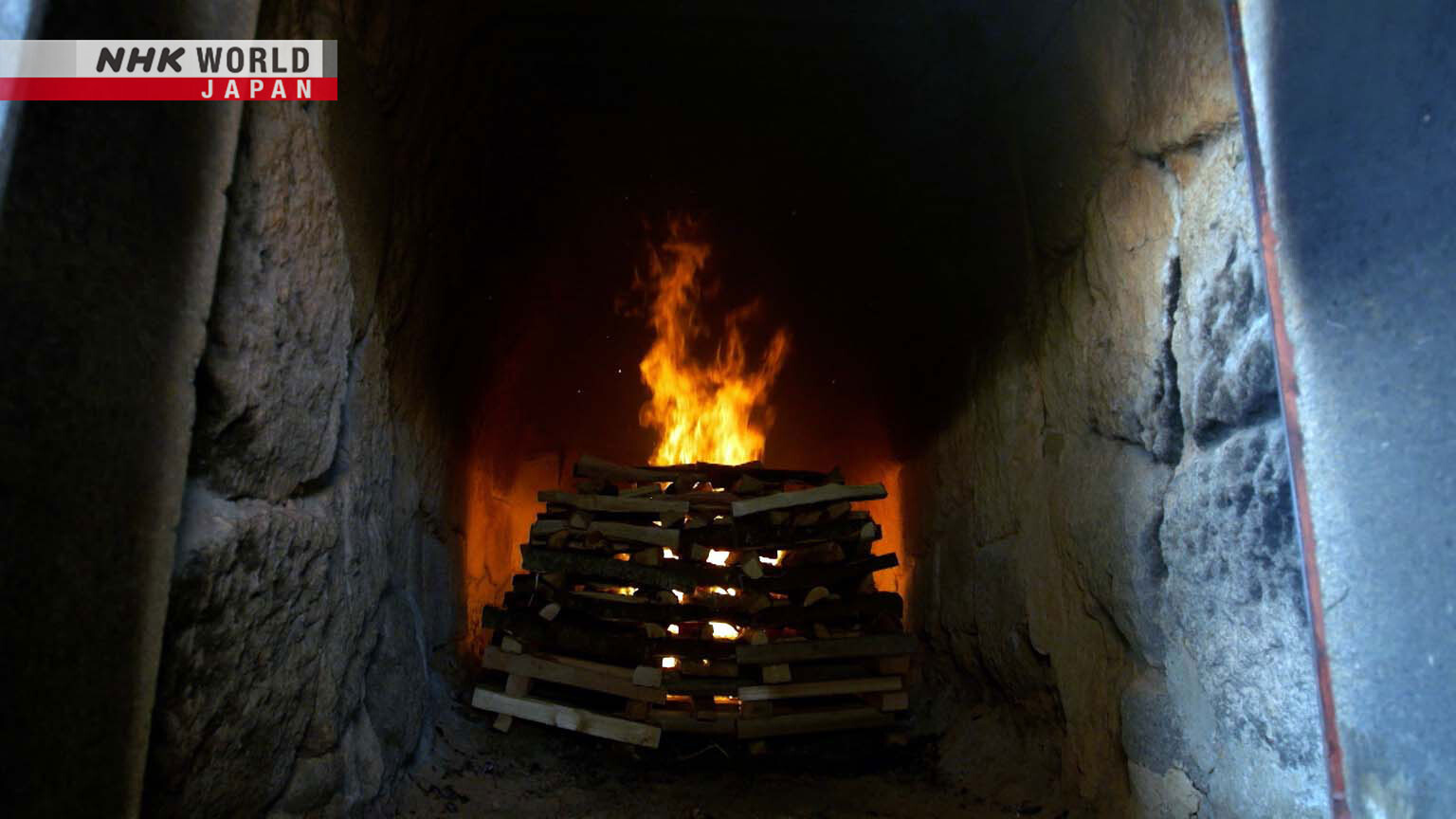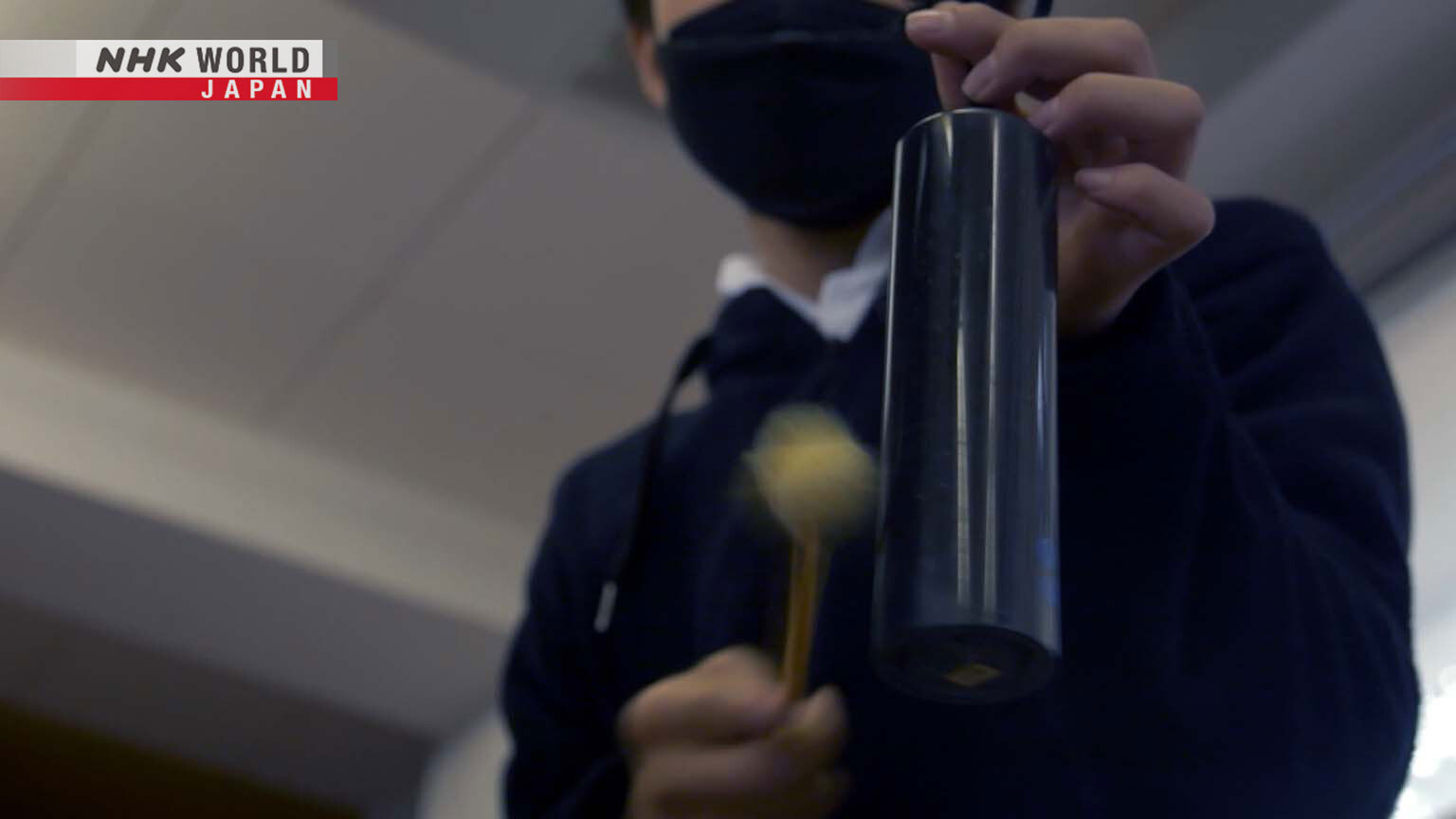Seto Inland Sea: Life with Stones
The calmness of Seto Inland Sea, located in western Japan, will send your worries away. One thing that has been firmly supporting lives in this area is stone. The stone walls of the famous Osaka Castle are made of one million pieces of stone, most of which were granite quarried from the islands in the Seto Inland Sea, and shipped to parts of Japan. In this episode, we travel to the coastal area of the Seto Inland Sea, where life involves around reliable yet warm stones.
130 Years of Quarrying

Kitagi Island in Okayama Prefecture is an "island of stone," where granite is easily exposed under the topsoil. Granite is formed when magma slowly cools deep underground. The sound of stone being cut echoes through the island. To turn the hardship of the work into strength, "stone cutting songs" were born. The island's stones, known as "Kitagi-Ishi," have been used for Shinto shrine gates and historical buildings in Japan.
The Super-Hot Stone Bath

The coastal area of the Seto Inland Sea has a bath culture that has continued for over a millennium. It is the "stone bath," a type of steam bath carved in rock. The custom of soaking in a bathtub spread in Japan only about 300 years ago, and prior to that, these stone baths were commonly used. Their remnants can still be found in many places. We found one stone bath that is still in use in Sanuki City, Kagawa Prefecture. With the recent sauna boom in Japan, the stone baths have lately become popular among young people.
Melody of Ancient Stones

Sakaide City is located in Kagawa Prefecture, an area once known as Sanuki. During sixth graders' music class at a local elementary school, the students use instruments made from a stone called "Sanukite," a type of andesite formed by volcanic activity from circa 14 million years ago. The namesake of Sanukite comes from the region's old name. The high, clear tone of Sanukite is due to the denseness of the stone, making the speed of the sound travel faster, sending echoes of the ancient stone with a timeless melody.
Transcript
From the four winds and the scent of the earth,
come the color of the seasons.
Exploring the four seasons of Japan.
3...2...1... jump.
OK.
The calmness of this sea will send your worries away.
This is Japan's Seto Inland Sea.
"I like this one."
"That's cool."
Surrounded on all sides by three of Japan's main islands,
the Seto Inland Sea is home to more than 700 islands of various sizes.
A sea of blessings; a sea that carries and delivers people and goods.
Different livelihoods of families are passed down to the next generation.
This is my dad's boat's name.
One thing has been firmly supporting lives in this area, but keeps a low profile.
It is stone.
The stone walls of the famous Osaka Castle are made of one million pieces of stone.
Most of these were granite quarried from the islands in the Seto Inland Sea, and shipped to parts of Japan.
These high-end stones are today popular as gravestones.
But new possibilities are being explored.
"I wanted to do something new with stones other than gravestones."
"I wanted the stones to have a closer affinity to people."
In this episode of Seasoning the Seasons, we travel to Setouchi,
the coastal area of the Seto Inland Sea, where life involves reliable yet warm stones.
The Seto Inland Sea is located in western Japan.
It is surrounded by three of the four main islands that make up Japan; Honshu, Shikoku and Kyushu.
Our first stop is Iwai Island, part of Kaminoseki Town, Yamaguchi Prefecture.
It's about 12km in circumference.
A close community of about 300 people live on the island.
The roads on the island are narrow and cars cannot pass.
We find a grocery store which doubles as a tourist information center.
- "Hello."
- Welcome.
There are 3 grocery stores, and one liquor store on the island.
Kunihiro Hideto was born and raised on Iwai Island.
His main business is a guest house he inherited from his parents,
but he also manages the grocery store and provides tourist information.
That's 200 yen change. Thank you.
Hideto gives us a tour of the island.
This is a beautiful place with "nerihei" on both sides.
"Nerihei" are walls made of clay and piled stones, built during the 19th and 20th century.
The walls are unique to Iwai Island and are not found on surrounding islands.
It's said they were built as windbreakers from the winter monsoons, westerly winds,
and typhoons, which are quite strong here.
Hideto recommends we go and see terraced rice paddies made with piled stones.
It's quite far away. 4km from here.
It'll take about an hour on foot.
There is very little flat land on the island.
Once you leave the main settlement, steep uphill slopes seem to go on forever.
"Hello."
After an hour of walking, a fortress-like stone wall appears.
"Hello!"
Hello.
- Be careful, the path is bad.
- "OK."
- A long way up here, right?
- "It was."
Taira Manji's family built these stone terraced rice paddies starting with his grandfather.
We built all this with just our family.
We didn't get any outside help, we built it by ourselves.
"You carried all these stones here?"
No, they were all here.
Lying around in the bushes.
We found them all and piled them up with levers.
- "With levers?"
- Only levers. We had nothing else.
It took three generations of the Taira family about 100 years,
quarrying the stones from the hill behind their house, and piling them up one by one.
We moved the stones with this.
Everyone held a lever, and we all shoved it in from behind in unison, and lifted it up.
Then, when we did this, it came out.
- "This big stone?"
- That's how they are stacked together.
Unbelievable, huh?
Manji continued to grow rice here until 2015, when he was 82.
It all started with his grandfather, Kamejiro who wanted to expand his rice paddies, even if only slightly.
So, he cut through the hill and began stacking the stones.
When Manji was 12 years old, his father died,
and he and his grandfather continued to keep and expand the terraced rice paddies.
His grandfather passed away in 1958.
I lived with my grandfather during summer and winter vacations. He made me help him.
My life has been about these stones, ever since I can remember.
My whole life was a challenge with the stones.
Sometimes I look at my hands and think, 'they worked hard.'
They're a trophy.
Kitagi Island in Okayama Prefecture is an 'island of stone,' where granite is easily exposed under the topsoil.
Granite is formed when magma slowly cools deep underground.
That whole surface of the hill over there.
They dug up the top of that hill too.
The sound of stone being cut echoes through the island.
To turn the hardship of the work into strength, 'stone cutting songs' were born.
"If you want to be a bride, marry a stone cutter."
"You'll be surrounded by money right and left."
Fujii Atsushi, a retired stone cutter, is the chairman of the stone cutting song preservation society,
as well as a tourist guide on the island.
The island's stones, known as 'Kitagi-Ishi,' have been used for Shinto shrine gates and historical buildings in Japan.
Tsuruta Yasunori is the fourth-generation proprietor of a stone company that has been in business for 130 years.
He continues the long-established enterprise known for its high-grade gravestones.
Let's say you cut stone into thin sheets.
They will bend like this, right?
It's the flexing.
Hard stones crack easily.
Kitagi-Ishi stone will flex, but will not break.
Over the years, Kitagi-Ishi has enjoyed a great reputation.
But in the past 30 years, its demand has continued to decline due to inexpensive foreign stones.
Welcome. Would you like to visit the lookout?
To better promote Kitagi-Ishi,
Yasunori has created a tourist attraction where visitors can observe the quarry in action.
Today, there is a tourist who has traveled 500km to see the quarry.
- Thank you for coming. Where are you from?
- "Nagano."
You came that far?
I've been wanting to come here for a while. But the view makes me dizzy.
Not sure about this. Oh my...
Since its establishment the Tsuruta family business has survived on this single quarry, which is now over 100 meters deep.
"It's about 40 meters below sea level."
"There's a pool of water that is 40 meters deep."
"Cheap foreign stones took over the market. So I built the lookout."
Now, for the first time since its founding, Yasunori is digging a new quarry.
This is to meet new demands other than gravestones.
"Now that there's a need, we are willing to take on a challenge."
"It all started with the flood disaster in western Japan that also affected us."
The stonewalls of Marugame Castle collapsed.
The stone walls of Marugame Castle in Kagawa Prefecture collapsed in the 2018 heavy rain disasters in western Japan.
If Yasunori were to join the restoration efforts,
the existing quarry alone would not be sufficient to handle the workload.
Even if the new quarry doesn't lead to immediate business,
it should lead to the future of Kitagi Island.
"For the first time in 130 years, we are cutting trees,
removing topsoil, and starting a new quarry."
"We are not trying to be intrusive, but if we can help at all, we'd like to cooperate."
"If we don't get the work, then we'll do our best again -
to use the stones for something else."
The coastal area of the Seto Inland Sea has a bath culture that has continued for over a millennium.
It is the stone bath, a type of steam bath carved in rock.
The custom of soaking in a bathtub spread in Japan about 300 years ago.
Prior to that, these stone baths were commonly used.
We found one stone bath that is still in use in Sanuki City, Kagawa Prefecture.
Although once closed due to financial difficulties,
locals formed a preservation society and revived it,
to prevent the extinction of this important local culture.
Okada Toshiro is in charge of the furnace of the stone baths.
The baths are open four days a week.
It's a really primitive method.
Firewood is burned in a space made of stacked stones filled with clay.
Once heated, the stone does not cool down easily, and remains hot enough until the next day.
It is a heated air bath similar to a sauna.
"It's a unique part of Setouchi culture. They didn't have them in hot springs regions,
but there were many in the Seto Inland Sea area."
The stone bath is said to be the origin of baths in Japan.
It is believed they were built here 1,300 years ago.
But how do you use the stone bath?
First, straw mats, soaked in plenty of water, are prepared.
While protecting your body from the heat with a blanket, the mat is laid over burning charcoal.
Sitting on top the mat, bathers 'enjoy' the heat.
The heat is intense. That's how high the temperature is.
But you won't catch colds.
It's very effective.
At noon, the stone baths open.
Regular visitors start to arrive.
- "Is there a bathing method?"
- Method? Sure.
The stones on both sides are hot, so put on a hood,
sit on a cushion, put a blanket over your head, and go inside.
I'm from Aichi.
I googled 'sauna' and 'Kagawa,' and found this place.
With the recent sauna boom in Japan, and the boost from social media,
the stone baths have lately become popular among young people.
So, how are things inside?
- "It's hot."
- "The heat stings."
"Saunas are usually about 80 degrees Celsius,
but these can get up to 150 or 160."
"It's a different kind of heat."
What's the temperature?
A little cooler at just over 140 degrees!
So hot.
- "You look good."
- Thank you.
- "It's boiling hot."
- Boiling?
Safety measures are in place, but be prepared for the intense heat.
It's hot.
I've been coming here for 34 years. It's my lifesaver.
Our next stop is Ushimado Town in Setouchi City, Okayama Prefecture, which boasts a beautiful view of the sea.
An olive grove adorns a hill overlooking the ocean.
It is a tourist destination visited by many, but if you look around carefully...
you will see large stone structures here and there.
It's amazing. I wonder how they carried the stones here. It's built so cleverly.
"Can you go inside?"
It looks a little scary, but let's go inside a little.
These are burial mounds of a local powerful clan from the 6th to 7th centuries.
This burial mound is also wonderful.
"The stone chamber is open to the south,
always looking out to a very nice view."
Maybe the clan chose this location for the Seto Inland Sea view.
During the samurai era, Ushimado was the logistics hub of the Okayama domain, where ships came and went.
On the island of Maejima, stone was actively quarried and transported by sea.
Good quality granite is available throughout Japan, but transporting it by land cost labor and time.
Instead, on the calm Seto Inland Sea, sea shipping was active,
and many skilled boatmen were available to ship large amounts of stone quickly and cheaply.
In modern times, vegetables began to be shipped from Maejima Island.
Maejima's cabbage, picked in the spring, is renowned for its sweetness.
After 30 years of experimenting with various seeds, Ota Osamu arrived at this sweet variety.
Osamu says the secret of the sweetness is the well-drained soil created by decayed stone.
This is soil, but it's basically small pieces of stone.
It drains well and is good for vegetables.
Even if you harden the soil, it's still loose.
So, you can grow sweet cabbages and delicious watermelons.
That's the sweetest part of the cabbage.
"So sweet. That's cabbage?"
A stone shrine stands in a corner of the field.
It's for the local mountain deity.
At New Year's, we make rice cakes, put up the sacred straw rope and flags,
and give the rice cakes as an offering.
The Ota family has been in Ushimado for 10 generations.
Records tell what their ancestors did for a living.
"There are documents by the temple -
that says they were chief stone cutters."
So we often find these large stones in the field.
Osamu's wife Masayo is going to treat us with a cabbage dish.
Roughly chopped cabbage.
Add some soup stock. Some pork belly. Ready in no time.
It only takes five minutes to cook.
Add the lemon in.
Pretty, right?
"At first, I wasn't sure about lemon hotpot. I was like 'can you eat that?'"
"Once I tried it, I was hooked."
The meat color has changed, so it's ready.
Let's eat.
It's sweet.
"We believe it's the best cabbage in Japan."
"Today, the Seto Inland Sea remains a source of high-quality granite."
"The speed at which the magma cools give rise to the uniqueness of the stone."
"This is Aji Stone. It's a very fine granite. Finer granite is denser and -
harder than coarser ones, which means it weathers less."
"Aji Stone production areas"
"Aji Stone has long been prevalent as a gravestone."
"Its price is about three times higher than ordinary gravestones."
"But the stone has many natural blemishes."
"The percentage of mined Aji Stone made into products is extremely low at 2%."
"So it's bound to be expensive."
"Tomoyuki is now exploring new possibilities for Aji Stone."
"This is a footbath."
As a maker, I feel I have to keep coming up with new ideas.
"He has spent several months developing a guitar made of Aji Stone."
It has the same structure as an ordinary guitar. But it's not light.
"Tomoyuki's wish is to make stone a more familiar material."
Sakaide City is located in Kagawa Prefecture, an area once known as Sanuki.
During sixth graders' music class at Kanayama Elementary School,
the students use instruments made from a stone called "Sanukite."
Sanukite can be found on the ground here and there.
We see it on our way home.
Sanukite is a type of andesite formed by volcanic activity that happened about 14 million years ago.
The stone can be sourced in several places in Kagawa Prefecture.
Sanukite, the stone of Sanuki.
It's high, clear tone is due to the denseness of the stone, making the speed of the sound travel faster.
Akiyama Gen is currently the only craftsman of the Sanukite instrument.
The most difficult thing is,
it never goes the way you want it to.
The stone is cut so that a cylindrical cavity remains inside, but it can crack with the slightest force.
Moreover, you don't know what kind of sound it will make until it's finished.
So, when I'm able to finish one properly, it's a special moment.
"Good. It cut nicely."
"How is the sound?"
I think it's great.
When it sounds this good, I don't have to be angry for the rest of the day.
I'm so happy.
Sanukite is a rare stone that can only be found in a few places in Kagawa and Nara prefectures in the entire world.
An ancient stone that echoes with a timeless melody.
It's another calm day on the Seto Inland Sea.
Stones have always played an integral part in the lives of local residents.
Their new stories will continue to pile up, one stone at a time.